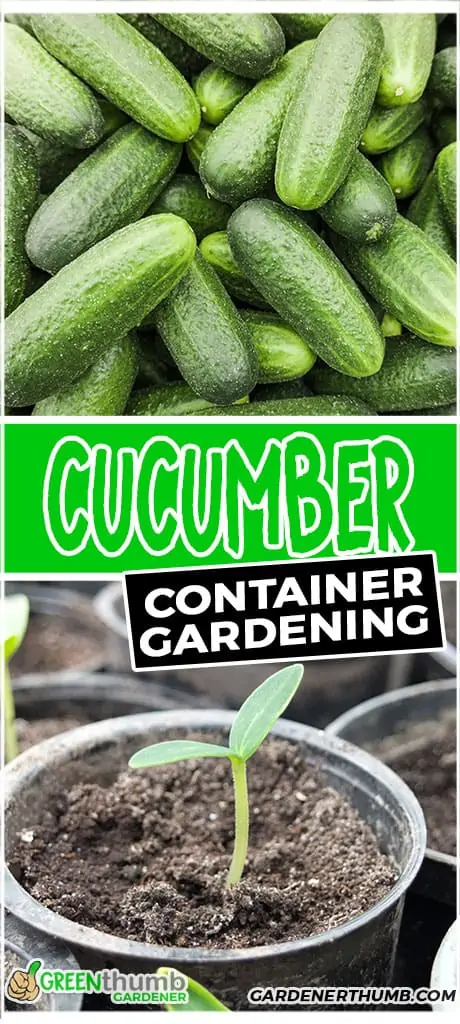Growing Cucumbers in Containers
Last updated: 05/24/21
You might be wondering if you can grow cucumbers from seed if you are limited for space. Maybe you grew tomatoes on your balcony before, but not quite certain if it would work to grow cucumbers in pots.
Cucumbers need to vine up and can grow all over the place but is if ok on a porch?
Growing cucumbers in containers is actually pretty easy when you follow our best tips below.
Green thumb Gardener occasionally links to product and/or services offered by vendors to assist you with all your gardening needs. Some of these may be affiliate links, meaning we earn a small commission if items are purchased.
Want to Download a Garden Hack Guide for FREE

Enter your email below and we will send you a guide to help you SAVE money in your garden.
Ideal Containers & Best Soil To Grow Cucumbers
You need a container and the right type of soil as the minimum to get started. We give you our thoughts on how to select the right options.
Best Containers To Use For Cucumbers
Virtually any large, clean container with drainage holes will work for growing cucumbers. This vegetable needs room for their roots to grow, so it makes sense to choose a larger container.
After all, the plant will be several feet tall or more, so it makes sense that the extensive root systems need room to spread out to support the plant. Your container size should be at least 12 inches (30 cm) deep, with optimal size of 16 inches (41 cm) deep or more.
It should be at least 10 inches (25 cm) wide for one plant. The wider your container, the more plants you can grow in one pot.

A 5-gallon bucket from the hardware store will work just fine provided you drill holes in the bottom for drainage. You can also use other larger containers, such as a planter or even a deep window box.
You may want to find a container that you can put a sturdy trellis in, or attach a strong trellis to the side of the pot.
Choose a spot in your garden space with good exposure to sunlight.
Soil
The quality of your organic potting soil mix will have a big impact on the quality of your cucumber plant!
Be sure to use quality potting soil that has been amended with compost or organic matter so that it will nourish the plants.
It’s also important to use plenty of soil that has good drainage, so be sure to mix in some perlite or vermiculite. Drainage holes in the bottom of the container are also crucial.
The advantage of growing in a container is that you can completely control the quality of the soil you use. Some gardeners choose to use liquid fertilizer or granular fertilizer to ensure fertile container soil throughout the growing season.
Any all-purpose fertilizer will work.
Best Varieties of Cucumbers to Grow In Containers
There are two types of cucumber: bush and vining varieties.
Bush cucumbers still produce vines, of course, but they work best in containers since the plants are more compact. The good news is that among bush styles, there are a wide range of common cucumber choices.
Some of the best varieties of cucumbers for container gardening include:
- Marketmore
- Spacemaster
- Bush Slicer
- Picolino
These compact cucumbers for pots tend to grow with shorter vines, tend to be disease resistant, and produce lots of cucumber fruit.
You can grow both slicing cucumbers and pickling cucumbers in pots. You can grow vining cucumbers in containers as long as you have a lot of room for a large support structure, as the fines may grow to longer than six feet.
When Is The Best Time To Plant Cucumbers in Containers
Planting time for most cucumbers will be after the danger of frost has passed. To ensure the cucumber seeds will germinate, place your planter filled with soil in the outdoor location where you’ll be keeping it.
Wait to sow until the soil temperature warms past 60 degrees. If you live in a cold climate and choose to start your seeds indoors, you can get a head start by sowing seeds about a month before the frost-free date for your growing zone.
Be sure to harden them off and wait until the danger of frost has passed before planting them out in your container. This process of taking time to gradually acclimate them to the outdoor conditions will ensure that they thrive in their new environment.

Your cucumber seed packet will also provide useful information about when to plant out in your area.
Grow Cucumbers In Container Tips
Planting
Fill your container with soil and sow cucumber seeds half inch to one inch deep, using the recommendation on your seed packet for instruction. Leave about three inches between each seed.
It’s smart to plant several seeds just in case any do not germinate.
Water
It’s important to ensure that your cucumbers have plenty of water!
They end up being about 90% water, so you can see why they need so much of it while they grow. It is important to monitor the soil moisture to make sure it doesn’t dry out.
One advantage of larger containers is that they retain water longer and don’t dry out as quickly. Self-watering planters make it easy to ensure that the cucumber plants won’t ever dry out.
You can check the soil moisture by touching the surface with your fingertips. If it feels moist, the container does not need water.
If the soil surface is dry to the touch, slowly water until you see water flow out of the drainage holes in the bottom.
Common Pests and Disease
Cucumbers are susceptible to a few common disease issues while growing. Cucumber beetles and squash bugs are the most common pests and can be carriers of diseases.
Happily, garden pest control can be as easy as applying mild soapy water to the plants. You can also deter cucumber beetles by spraying them with neem oil.
If you check the underside of the leaves and see orange eggs, destroy them so they can never grow into adult beetles. Squash bugs are slow enough that you may be able to pick them off and dispose of in a bucket of soapy water.
Another common problem is powdery mildew. This fungus will appear as a white powder on the leaves and is often found when there is high humidity.
To get out ahead and prevent it, be sure that the plant has plenty of airflow around the leaves. If your cucumber plant has started showing signs of powdery mildew, you can spray it with one part milk and ten parts water.
Repeat this weekly to control or even eliminate this disease.
Maximize Your Yield
Just because you are growing a container garden doesn’t mean you are limited as to the number of cucumbers you can grow!
Organic fertilizer can increase the quality and number of cucumbers your plant will produce. Regular watering will also help, as will placing your container where it gets at least six hours of sunlight every day.
These tips will help you get optimal flavor from your cucumbers. You can also increase your yield by using succession planting.
This technique uses staggered planting dates so that when the first plant has finished fruiting, you have another plant that is still producing fruit.
Two weeks after you sow your first seeds, sow seeds in a second container. If your growing season is long and you have room for several containers, you may be able to do this a few times.
Harvest
The time to maturity is about 12 weeks after the seeds are sowed. Check your seed packet for more precise days to maturity. You will know when you have ripe cucumbers based on the size, again using the seed packet for specific information.
To harvest your fresh cucumbers, use a sharp knife or garden clippers to cut the cucumber off the vine.
Pulling or twisting with your hands might damage the vine and reduce your chance of future harvests.
Cucumbers harvested early in the day are said to have better flavor and texture. If you leave a cucumber on the vine too long, it may become bitter.
Trellising Cucumbers in Containers
Even using the more compact bush style cucumbers, your plants will still need a support structure. You can use a strong trellis, some stakes or sticks, or even a tomato cage.
Make sure your support structure is sturdy, as cucumber vines can get heavy once they start producing. This also takes advantage of vertical space.
Another advantage of using a support structure is that the cucumber fruit will hang off the vine, making them easier to find and harvest.
Final Thoughts
Growing tasty, crunchy cucumbers in containers can be fun and easy.
Just read this gardening advice and find a little bit of room for a five-gallon container and you will soon be snacking on delicious cucumbers!
Related Questions
How deep should a container be for cucumbers?
A container growing cucumbers should be at least 12 inches deep, preferably 16 inches or more.
Can you grow cucumbers in a 5 gallon bucket?
Yes, you can grow cucumbers in a 5 gallon bucket, as long as you drill drainage holes in the bottom.









